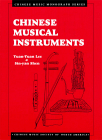Chinese Musical Instruments (Chinese Music Monograph Series)
Last updated: 17.12.19

| Printed: | 1999 | Author: | Yuan-Yuan Lee |
| Publisher: | Chinese Music Society of North America | ISBN: | 1880464039 |
| Suppliers: | 





|
Paperback - 208 pages (May 1999), usually ships within 24 hours.
Amazon Review
From the Author Pursuing our exploration of the almost limitless caverns of Chinese music and musical instruments, so much of which has never yet come to the knowledge of the rest of the world, we approach the subject from both the angles of principles and practice. Functional discussions of musical interest, cultural molding of musical psychology, instrumental effects and acoustics are emphasized. The exploration centers on the principle of cultural acoustics, i.e. the impacts of musical acoustics is strongly modified by our ear and brain which are products of culture. This popular book is written so that it requires no prior knowledge of Chinese music or acoustics. Also, no knowledge of the Chinese language is assumed. With the opening chapter we find ourselves at a focal point in the present study: The Cultural Acoustics of Chinese Musical Instruments? The cultural preference of harmony, and thus intervals and tones and rhythms used in music, distinguishes one music from another. Chinese music, however, is unique in its uninterrupted history of more than 8000 years and very early development of theoretical systematics, acoustical and material science, and orchestral practice. The bronze bell chime is perhaps the ultimate percussion instrument. The world's first double reed instrument, the guanzi, is really not a double reed using present day nomenclature. The qin is timeless in the true sense of the word. The Chinese orchestra is several dozens of acoustically unified and musically interesting orchestras, primarily based on reeded wind and plucked strings as orchestral tone quality bases. The principal instrumental subgroups of reeded wind, plucked string, and bowed string are then studied in detail in succeeding chapters. The orchestral roles, acoustics, performance practice, orchestration techniques and repertoire of each group form the key areas of discussion. Numerous practical examples are used throughout to aid the discussion.
Excerpted fromChinese Musical Instruments
From Chapter 1: Years ago, while we were still developing the field of Cultural Acoustics, many colleagues asked me, "I've been playing the erhu for a while now - how come I still can't get the proper tone - It just doesn't sound Chinese!" There the connection between tone and cultural acoustics is but one aspect of the problem. The music of China is built on a specific harmonic system, and that harmonic system is not only different but also broader than what is known in the West.

